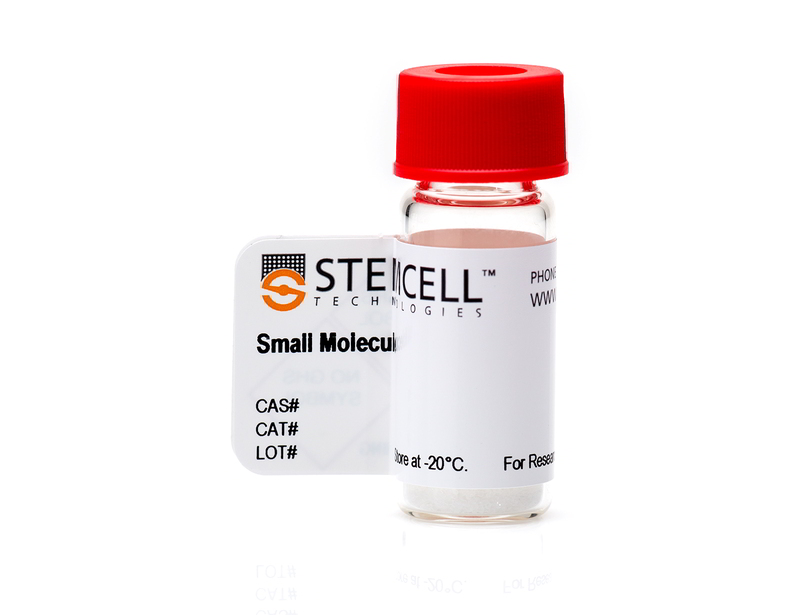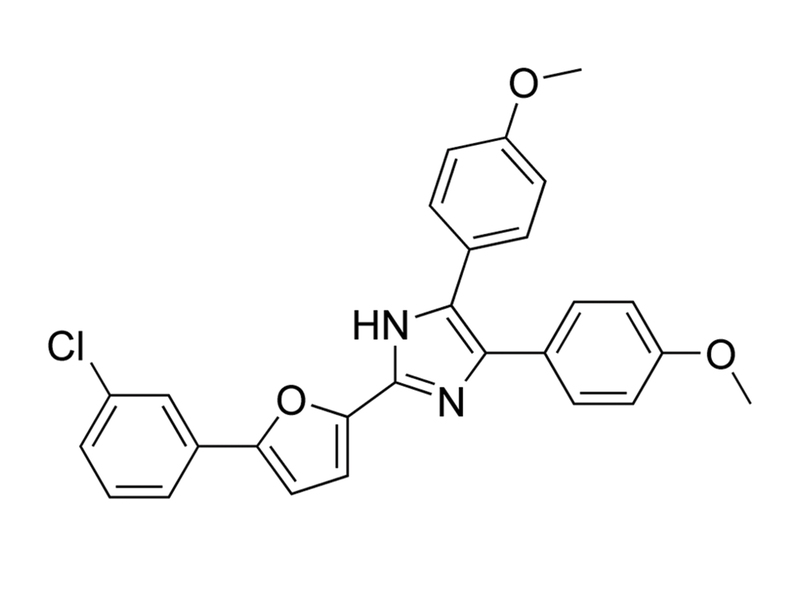概要
Neurodazine is a cell-permeable tri-substituted imidazole and neurogenic agent (Williams et al. 2007).
DIFFERENTIATION
· Induces neurogenesis of C2C12 myoblasts as well as mature human muscle cells, marked by upregulation of neural genes (Williams et al. 2007; Williams et al. 2008).
· Induces neurogenesis and prevents astrocyte differentiation of P19 mouse embryonic carcinoma cells (Kim et al.).
· Induces neuronal differentiation of human (SH-SY5Y) and mouse (Neuro-2a) neuroblastoma cells, and mouse NIH3T3 fibroblast cells (Halder et al.).
DIFFERENTIATION
· Induces neurogenesis of C2C12 myoblasts as well as mature human muscle cells, marked by upregulation of neural genes (Williams et al. 2007; Williams et al. 2008).
· Induces neurogenesis and prevents astrocyte differentiation of P19 mouse embryonic carcinoma cells (Kim et al.).
· Induces neuronal differentiation of human (SH-SY5Y) and mouse (Neuro-2a) neuroblastoma cells, and mouse NIH3T3 fibroblast cells (Halder et al.).
技术资料
| Document Type | 产品名称 | Catalog # | Lot # | 语言 |
|---|---|---|---|---|
| Product Information Sheet | Neurodazine | 73292 | All | English |
| Safety Data Sheet | Neurodazine | 73292 | All | English |
数据及文献
Publications (4)
Molecular bioSystems 2015
Synthetic small molecules that induce neuronal differentiation in neuroblastoma and fibroblast cells.
Abstract
Abstract
An investigation was conducted to demonstrate that neurodazine (Nz) and neurodazole (Nzl), two imidazole-based small molecules, promote neuronal differentiation in both neuroblastoma and fibroblast cells. The results show that differentiated cells generated by treatment with Nz and Nzl express neuron-specific markers. The ability of Nz and Nzl to induce neurogenesis of neuroblastoma and fibroblast cells was found to be comparable to those of the known neurogenic factors, retinoic acid and trichostatin A. In addition, the cells differentiated by Nz and Nzl are observed to express different isoforms of glutamate receptors. The results of signaling pathway studies reveal that two substances enhance neurogenesis in neuroblastoma cells by activating Wnt and Shh signaling pathways and neurogenesis in fibroblast cells by mainly activating the Wnt signaling pathway. Observations made in the present study suggest that Nz and Nzl will serve as chemical tools to generate specific populations of neuronal cells from readily available and simply manageable cells.
Angewandte Chemie (International ed. in English) 2014
Imidazole-based small molecules that promote neurogenesis in pluripotent cells.
Abstract
Abstract
Reported herein are two imidazole-based small molecules, termed neurodazine (Nz) and neurodazole (Nzl), which induce neuronal differentiation of pluripotent P19 cells. Their ability to induce neurogenesis of P19 cells is comparable to that of retinoic acid. However, Nz and Nzl were found to be more selective neurogenesis inducers than retinoic acid owing to their unique ability to suppress astrocyte differentiation of P19 cells. Our results also show that Nz and Nzl promote production of physiologically active neurons because P19-cell-derived neurons induced by these substances have functional glutamate responsiveness. The present study suggests that Nz and Nzl could serve as important chemical tools to induce formation of specific populations of neuronal cell types from pluripotent cells.
Nature protocols 2008
Fluorescent high-throughput screening of chemical inducers of neuronal differentiation in skeletal muscle cells.
Abstract
Abstract
This protocol describes detailed procedures for the fluorescent high-throughput screening of small molecules that induce neurogenesis in cultures of skeletal muscle cells. The detection of neurogenesis relies on a fluorescent dye, FM 1-43, which is used to study the neuronal property of depolarization-induced synaptic vesicle recycling. Thus, small molecules with neurogenesis-inducing activity in skeletal muscle cells can be rapidly identified by measuring the fluorescence intensity of the treated cells using a fluorescent microplate reader. This protocol uses murine myoblast C2C12 cells for screening, which are readily available and relatively easy to culture. Neurogenesis of PC12 cells induced by nerve growth factor is employed as a positive control for this screening. The screening time for this protocol is 8 d, which also includes the procedure to detect depolarization-induced synaptic vesicle recycling using FM 1-43.
Journal of the American Chemical Society 2007
Synthetic small molecules that induce neurogenesis in skeletal muscle.
Abstract

 网站首页
网站首页




